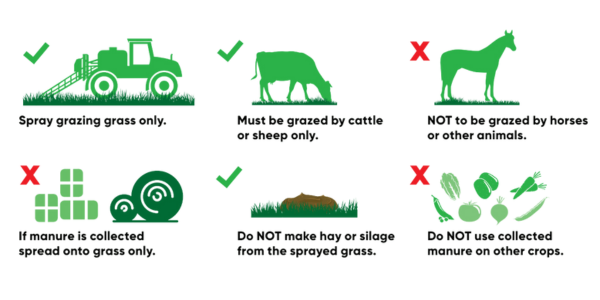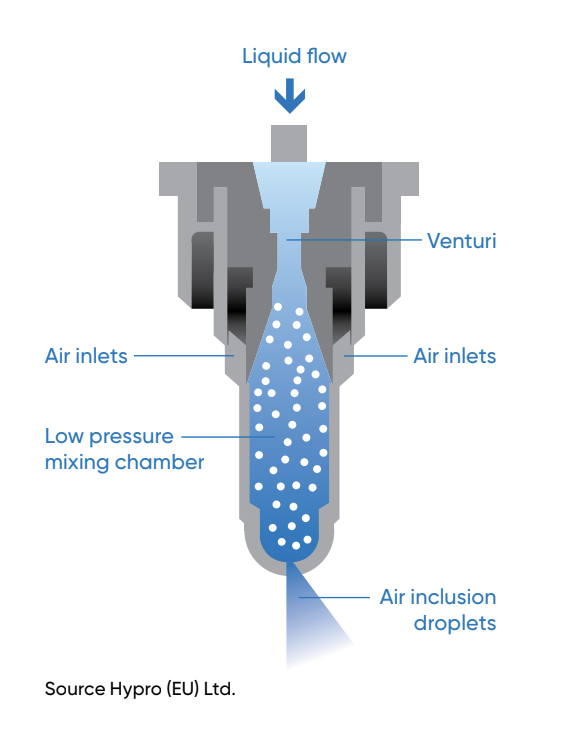Scroll down to find out how to optimise use of Forefront® T & Halcyon® whilst protecting water. Alternatively, you can download the information in PDF format by clicking here.
Forefront® T & Halcyon® stewardship

Recommending Forefront® T & Halcyon®
Forefront T and Halcyon are the best solutions for controlling weeds such as docks, nettles, thistles, buttercups, dandelions and ragwort. These products should only be applied to established grassland where cattle or sheep are grazed, due to herbicide residues being carried over into grass that is utilised for zero grazing, silage, hay or haylage. The resulting manure will affect sensitive crops if used as fertiliser.
As part of the authorisation of these products, we require that all advisors who recommend them complete the relevant stewardship training. This ensures that users receive the best advice from qualified IASIS advisers before application.
Manure Management
- DO NOT use Forefront T on grass that will be cut for animal feed (i.e. fresh cut grass, silage, hay or haylage) as herbicide residues will carry over into the forage and unwanted growth effects can result if this manure is applied to sensitive crops like potatoes or tomatoes in a green house. The graphic shows the do’s and don’t’s.
- Applications to silage, hay and haylage fields should only be made after the final cut has been taken.
- Treated grass must not be cut for animal feed (i.e. fresh cut grass, silage, hay or haylage) in the calendar year of treatment.
- Animal feed (i.e. fresh cut grass, silage, hay or haylage) produced from the treated area in the following calendar year must stay on farm and manure from animals fed on this must stay on farm and be spread only onto agricultural grassland.


Water Quality
We recommend that Forefront T is applied by horizontal boom sprayer equipped with at least 75% Drift Reducing Nozzles (DRN).
DRN is typically an air inclusionnnozzle which creates larger droplets that contain small bubbles of air.
This coarser droplet enables thespray to travel accurately from nozzle to target. On impact the bubble bursts leaving smaller droplets across the leaf for absorption. This means less drift and more deposit of product on to the target leaf.
Travelling speed and water volumenwill determine the exact type of nozzle to use:
- Forefront T must be applied in 200 litres water/hectare.
- Optimal travelling speed when spraying grassland is typically in the range of 8 to 10kph depending on field conditions.
Nozzle selection must be an approved DAFM nozzle type.
Dealing with larger weeds in newly sown leys
When seedling weeds that have gone beyond the optimal growth stage for treatment, or where particularly docks are re-establishing from root fragments rather than seed, then use ‘ground cover’ to assess the feasibility of making an application of Forefront T at the higher rate of use available for established grassland.
Established grassland is defined as having more than 90% ground cover or older than 1 year, whichever comes first.

Determining ground cover
To determine ‘ground cover’, go to the Corteva Forage App. Use this link if you have yet to download it and select the ‘Ground Cover’ feature in the ‘Weed Control’ option.
Once a newly sown ley reaches more than 90% ground cover, then you have an option to move to the higher dose rate of 125g/ha.
Ragwort control
- Forefront T is particularly effective on Common ragwort ( > 90% control). Common ragwort (Senecio jacobaea) tends to be found on poorer quality pastures. It is normally a biennial plant. A rosette in its first year that in its second year sends up one or more leafy unbranched stems that usually extend to 30-90 cm high.
Application timing is crucial to achieve good levels of control. It is recommended to spray Common ragwort at the rosette stage, up to but before stem extension, when it is growing actively.
- Livestock must be kept out of the treated area until treated Ragwort has died and completely rotted down.

Re-seeding intervals
- Weed removal can lead to bare patches which may require over-seeding.
- Where over-seeding is necessary then our guidance on reseeding intervals for a range of plant species typically found in multi-species swards is shown here:
| Species | Re-seeding interval |
|---|---|
| Grass | 1 month |
| White clover | 4 months |
| Red clover | 4 months |
| Plantain | 4 months |
| Chicory | 4 months |
Forefront T & Halcyon stewardship training & support
If you are an advisor who needs training to recommend these products, you can contact the Corteva Technical Hotline on +44 800 6898899 or email ukhotline@corteva.com. Alternatively contact National Field Technical Manager, Liz Glynn on 086 844 5306 or email liz.glynn@corteva.com.
You can earn IASIS CPD Points by completing the course and Knowledge Check.
We ask that Advisors take this online course at least once every 2 years to ensure the proper use of these products.
